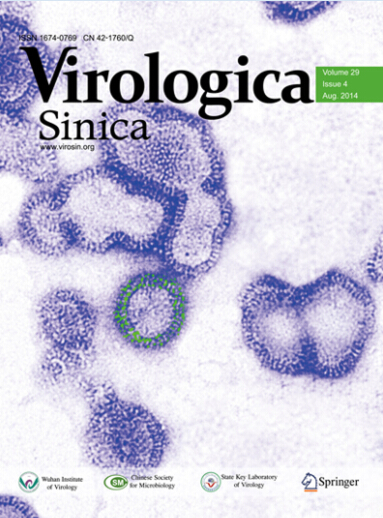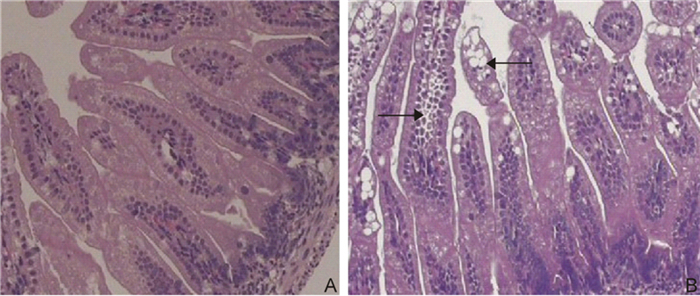-
Centers for Disease Control and Prevention (CDC). 2008.Rotavirus surveillance--worldwide, 2001-2008. MMWR Morb Mortal Wkly Rep, 57: 1255-1257.
-
Chen H, Gong S T, Ou W J. 2009. Expression of Aquaporins in Rotavirus Enteritis Treatment by Drug. Progr Modern Biomed.17: 3258-3261. (In Chinese)
-
Guttman J A, Samji F N, Li Y, Deng W, Lin A, Finlay B B. 2007.Aquaporins contribute to diarrhoea caused by attaching and effacingbacterial pathogens. Cell Microbiol, 9: 131-141.
doi: 10.1111/j.1462-5822.2006.00773.x
-
Hardin J A, Wallace L E, Wong J F, O'Loughlin E V, Urbanski SJ, Gall D G. 2004. Aquaporin expression is downregulated in a murine model of colitis and in patients with ulcerative colitis, Crohn's disease and infectious colitis, Crohn's disease and infectious colitis. Cell Tissue Res, 318:313-323.
doi: 10.1007/s00441-004-0932-4
-
Hodges K, Gill R. 2010. Infectious diarrhea: Cellular and molecular mechanisms. Gut Microbes, 1: 4-21.
doi: 10.4161/gmic.1.1.11036
-
Ikarashi N, Baba K, Ushiki T, Kon R, Mimura A, Toda T. 2011.The laxative effect of bisacodyl is attributable to decreased aquaporin-3 expression in the colon induced by increased PGE2 secretion from macrophages. Am J Physiol Gastrointest Liver Physiol, 301: G887-G895.
doi: 10.1152/ajpgi.00286.2011
-
Ikarashi N, Ushiki T, Mochizuki T, Toda T, Kudo T, Baba K. 2011.Effects of magnesium sulphate administration on aquaporin 3 in rat gastrointestinal tract. Biol Pharm Bull, 34: 238-242.
doi: 10.1248/bpb.34.238
-
Ishihara E, Nagahama M, Naruse S, Semba R, Miura T, Usami M.2008. Neuropathological alteration of aquaporin 1 immunoreactive enteric neurons in the streptozotocin-induced diabetic rats. Auton Neurosci, 138: 31-40.
doi: 10.1016/j.autneu.2007.09.002
-
King L S, Kozono D, Agre P. 2004. From structure to disease: the evolving tale of aquaporin biology. Nat Rev Mol Cell Biol, 5:687-698.
doi: 10.1038/nrm1469
-
Knipping K, McNeal M M, Crienen A, van Amerongen G, GarssenJ, Van't Land B. 2011. A gastrointestinal rotavirus infectionmouse model for immune modulation studies. Virol J, 8: 109.
doi: 10.1186/1743-422X-8-109
-
Krah D L. 1991. A simplified multiwell plate assay for the measurement of hepatitis A virus infectivity. Biologicals, 19: 223-227.
doi: 10.1016/1045-1056(91)90039-M
-
Laforenza U, Cova E, Gastaldi G, Tritto S, Grazioli M, LaRusso NF. 2005. Aquaporin-8 is involved in water transport in isolated superficial colonocytes from rat proximal colon. J Nutr, 135:2329-2336.
-
Ma T, Jayaraman S, Wang K S, Song Y, Yang B, Li J. 2001.Defective dietary fat processing in transgenic mice lacking aquaporin-1 water channels. Am J Physiol Cell Physiol, 280:C126-C134.
-
Sheridan J F, Eydelloth R S, Vonderfecht S L, Aurelian L. 1983.Virus-specific immunity in neonatal and adult mouse rotavirus infection. Infect Immun, 39:917-927.
-
Tsujikawa T, Itoh A, Fukunaga T, Satoh J, Yasuoka T, FujiyamaY. 2003. Alteration of aquaporin mRNA expression after small bowel resection in the rat residual ileum and colon. JGastroenterol Hepatol, 18: 803-808.
doi: 10.1046/j.1440-1746.2003.03033.x
-
Wang K S, Ma T, Filiz F, Verkman A S, Bastidas J A. 2000. Colon water transport in transgenic mice lacking aquaporin-4 water channels. Am J Physiol Gastrointest Liver Physiol, 279: G463-G470.
-
Yamamoto T, Kuramoto H, Kadowaki M. 2007. Downregulation in aquaporin 4 and aquaporin 8 expression of the colon associated with the induction of allergic diarrhea in a mouse model of food allergy. Life Sci, 81: 115-120.
doi: 10.1016/j.lfs.2007.04.036












